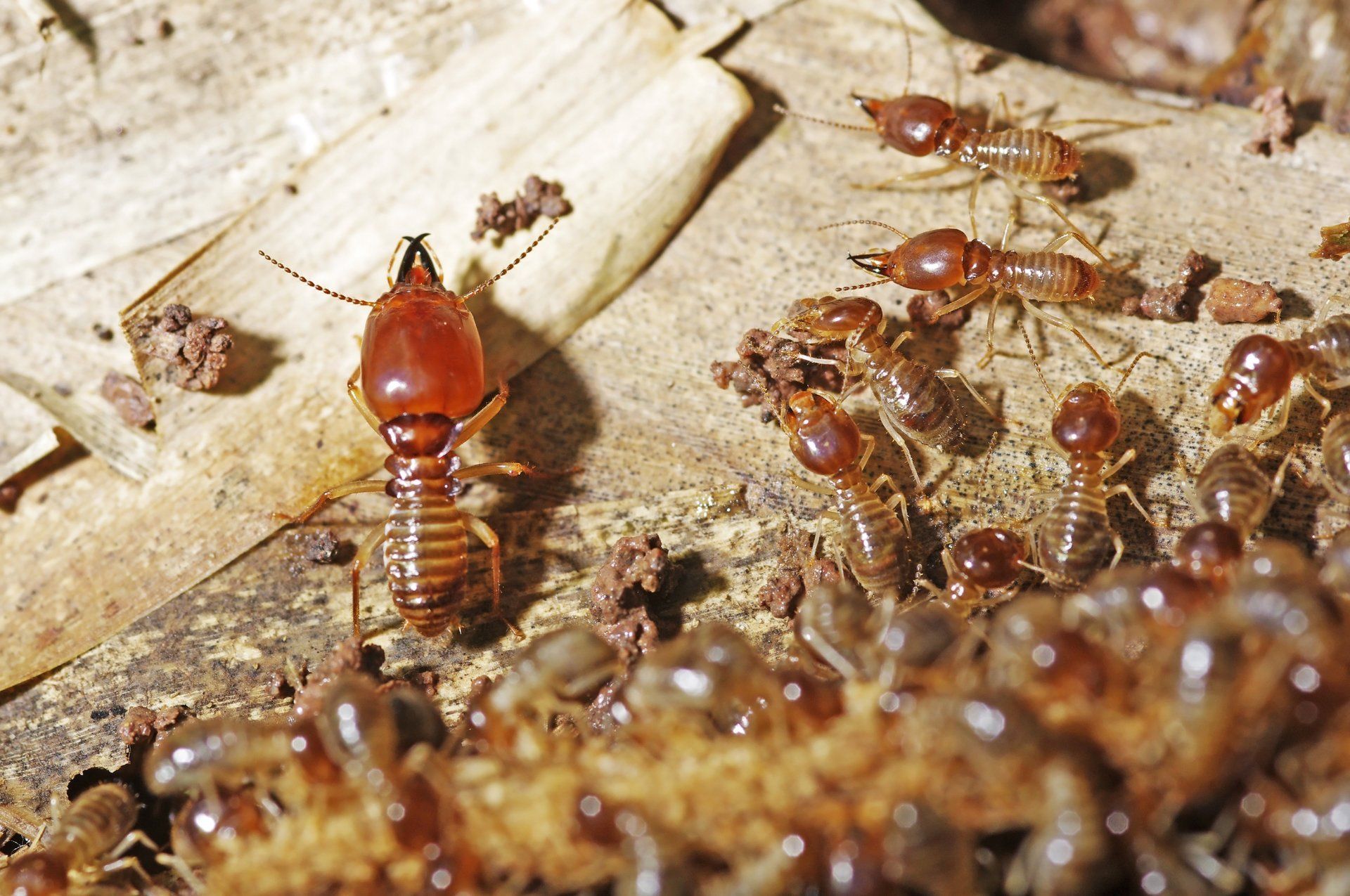Termites -EN
TERMITE (SOLDIER)

All termites live in nests or colonies. Individual classes (or "castes") of termites within the colony have their own roles and functions. Soldier termites defend the colony from attack. If a termite nest is disturbed, soldier termites will rush to "plug" any broken walls, tunnels ("mud tubes"), and/or areas where the nest has become vulnerable. As a result, you will, on occasion, see soldier termites outside of the colony itself.
Soldier termites resemble worker termites in several respects. For example, both castes have rounded bodies that are coloured a pale reddish-brown or white. However, a termite soldier can be easily distinguished from other kinds of termites. Look for termites that are larger than average, have heads that are darker or a different colour than their bodies and feature either protruding jaws or snouts. These soldiers make up about 1-10% of any given colony's termite population.
TERMITE (WORKER)

Commonly but erroneously called 'white ants' termites are the most destructive of wood-boring insects. They do not occur in the United Kingdom, but are widespread throughout the Tropics, the United States, Australasia and to a lesser extent Continental Europe. In addition to timber some species also attack standing trees, food crops and many other materials including plastics and rubber. Broadly speaking, they fall into two main groups: Its presence may therefore be accompanied by serious structural collapse of timber due to fungal decay.
Worker termites search out and collect food for the termite colony. Termite workers are also responsible for building and maintaining termite mud tubes and nests. They feed on cellulose, which is an essential component found in wood and grass. In nature, they’re helpful in the breakdown of dead and decaying materials. However, when worker termites seek to eat the wood in your home, they create devastating problems.
You can distinguish worker termites from other termites by their colour and size. Worker termites are pale or white, have rounded heads and bodies and straight antennae. They are smaller than the colony king and queen. Soldier termites, which defend the nest from ant attacks, also have pale or white bodies but possess dark heads and larger jaws. If you notice winged termites around your home, these are "swarming" termites. Like the king and queen, winged termites are “reproductive,” but they only lay eggs after they have flown away from the nest during swarming. Light brown to black in colour (depending on the species), winged termites are most likely to be visible in the spring.
TERMITE (QUEEN)

The Queen termite is the highest ranking in the colony and usually much larger in size than a worker and soldier termites of the same species. This is because the Queen holds thousand of eggs in her body and can lays up to 30,000 eggs a day. A queen termite has a long lifespan and is typically the oldest termite in the colony. Termite queens can live 25 to 50 years, with peak egg production for up to 10 years.
A subterranean termite queen can vary in colour from pale yellow-brown to black. Secondary reproductive in subterranean species are typically white or very light in colour – the same colour as worker termites for that species.
The role of the queen in a termite colony varies and changes over time. After pairing with a male, she begins her job as “founder” to get the colony started. She must locate a suitable nest site, help excavate it and then start producing eggs that will become workers.
The queen and king are groomed and fed by workers, which enter the royal cell through small openings in its hard-protective wall. Queens lay eggs at a steady rate every day. Workers move the eggs to incubation chambers.
Egg production is slow at first but increases year by year; the queen maintains peak egg performance for seven to 10 years. Once the secondary queens – which are produced within the colony – begin egg-laying, colony size (number of workers) increases rapidly.
The number of eggs produced by the queen varies depending on the species and the age of the queen. In tropical regions, egg production is continuous throughout the year, although there are seasonal fluctuations. In more temperate regions, termite egg production is often suspended during the cooler months.
After hatching, young immatures are taken to nursery chambers where they are fed and groomed by workers. They are moved to other chambers in the nest until their final moult into workers or soldiers.
A colony of about 1,000 workers at two years can multiply into 300,000 workers in five more years. Secondary queens are usually located in satellite nests away from, but connected to the main nest, so colonies can grow in size and number of individuals.
The queen, king and elates (termite swarmer’s) are considered the primary reproductive in a colony. In some cases, secondary or tertiary reproductive also can produce offspring. These secondary or tertiary reproductive do not have wings, although they may have wing buds.
When weather conditions are optimal, the queen produces elates, which will leave the nest to form new colonies.
When male and female winged termites mate to form a new colony, they first locate a suitable nest and hollow it out. Then, the queen begins laying eggs and cares for the first eggs. Once the queen lays enough eggs to establish a worker caste, the workers will begin caring for the eggs and expanding the size of the nest.
The queen is able to control the colony’s size and prevent the formation of secondary and tertiary reproductive through the production of a pheromone. Once the colony reaches a certain size, she may permit the development of secondary and tertiary reproductive. These reproductive create satellite nests near the colony and begin laying eggs. Once these satellite nests are established, the colony will begin to grow at an exponential rate.
The original queen in the colony is capable of chemically blocking development of the reproductive potential of all members of the colony. The king and/or queen produce a pheromone that circulates through the colony and inhibits the formation of other (secondary) reproductive.
The inhibitory pheromone produced by the queen prevents development of female secondary reproductive. This substance is circulated through the colony by immature stages that routinely consume the faeces of nestmates.
When the queen dies, production of the blocking pheromone stops, and secondary reproductive may be produced.
In the Reticulorumens species, the queen and king may be replaced by numerous secondary reproductive, and the colony may become very large with the added productivity of many queens.
Flip Book
View this information in a convenient flip book format.
View Flip Book
Download PDF
Download this information in PDF format for Print purposes.
Download PDF
Our Videos
Watch our series of educational videos.
Watch Videos

